Evaluation of Electric Vehicle Charging Usage and Driver Activity
Abstract
:1. Introduction
2. Electric Vehicle Charging Literature Review
3. Research Need
4. Research Objective and Scope
- To develop protocols for monitoring and quantifying charging station utilization through fixed video camera footage.
- Documenting and measuring driver activity during active charging sessions.
5. Data Collection and Study Location
6. Overview of Methodology
7. Results and Discussion
7.1. Analysis of Driver Activity While Charging
- Ahmad et al. utilized smartphone data to identify the driver and passengers of a vehicle. This analysis combined cell phone inertial measurements and GPS to determine the person’s entry location in the vehicle and classify them as a driver or passenger, which would aid in determining if a user remained in their vehicle or traveled to shops during their charging session [33]. They can also reduce processing and increase accuracy by incorporating vehicle data or door signals/activations.
- Connected vehicles currently provide information on GPS location, speed, heading, and other information to assess traffic signal performance [34], roadway mobility [35], and more recently have explored providing additional attributes for agency tracking, including lane keep assist data for pavement marking evaluation [36], and wheel sensor and drive train information for pavement quality [37]. This data can be used to provide insights on driver activity while charging through production vehicle sensors. Using CV data, such as air bag seat sensors, can help determine if the driver waits in their vehicle while charging or if they perform an activity outside of the vehicle [38,39].
- Finally, video analytics may provide a reasonable substitute for manually observing the images. Fixed cameras are currently used by transportation agencies and research to aid in vehicle detection for counting, tracking, and understanding activity [40]. Further AI developments have helped detect pedestrians to determine pedestrian/vehicle conflicts [41], tracking [42], and distances between identified objects in video [43]. This tracking of objects in video has been expanded through AI solutions to aid in multi-camera tracking of vehicles, which, upon further development, can aid in the classification of driver activity at EV chargers [44].
7.2. Analysis of Station Usage by Charger Capacity
7.3. Analysis of Usage with the Impact of Rain
7.4. Analysis of Charging Usage Dwell Time
7.5. Analysis of Station Usage by Time of Day
7.6. Analysis of Station Usage by Day of Week
8. Conclusions and Future Scope
- Over 4000 charging sessions across 16 charging stations were monitored for this analysis in the months of May, June, and part of July 2022 to monitor driver activity while charging, dwell time, and station utilization (Figure 2).
- Charging patterns by time of day and day of week were comparable to similar studies, with the highest utilization being on the weekends and between the hours of 11 a.m. and 6 p.m.
- Of the four charger types analyzed, the 50 kW charger was the least utilized, and the 150 kW Tesla charger had the highest usage.
- Driver activity while charging was categorized among six activities, with each activity impacting the average dwell time at the charging station. Drivers that would leave the premises would have dwell times of 30–60 min longer than those that waited in their vehicles.
- The weather impacted the use of public chargers, reducing the number of hourly charge sessions.
Author Contributions
Funding
Data Availability Statement
Acknowledgments
Conflicts of Interest
References
- Davenport, C.; Boudette, N.E. Biden Plans an Electric Vehicle Revolution. Now, the Hard Part. The New York Times, 13 April 2023. [Google Scholar]
- The White House. FACT SHEET: Biden-Harris Administration Announces New Standards and Major Progress for a Made-in-America National Network of Electric Vehicle Chargers. Available online: https://www.whitehouse.gov/briefing-room/statements-releases/2023/02/15/fact-sheet-biden-harris-administration-announces-new-standards-and-major-progress-for-a-made-in-america-national-network-of-electric-vehicle-chargers/ (accessed on 31 July 2023).
- Indiana Department of Transporation. Electric Vehicle Charging Infrastructure Network. Available online: https://www.in.gov/indot/current-programs/innovative-programs/electric-vehicle-charging-infrastructure-network/ (accessed on 31 July 2023).
- Staying Safe at the Pump. Available online: https://www.api.org/oil-and-natural-gas/consumer-information/consumer-resources/staying-safe-pump (accessed on 31 July 2023).
- From Zero to Charged: Understanding the Factors that Affect EV Charging Time. Energy5 Your Way. Available online: https://energy5.com/from-zero-to-charged-understanding-the-factors-that-affect-ev-charging-time (accessed on 31 July 2023).
- Ritchie, C. What Factors Affect EV Charging Speed? Save On Energy. Available online: https://www.saveonenergy.com/ev/charging-speed-tips/ (accessed on 31 July 2023).
- US Department of Transportation. Charger Types and Speeds. Available online: https://www.transportation.gov/rural/ev/toolkit/ev-basics/charging-speeds (accessed on 31 July 2023).
- TESLA. Charging Your Tesla. Available online: https://www.tesla.com/support/charging (accessed on 31 July 2023).
- Hecht, C.; Figgener, J.; Sauer, D.U. Analysis of Electric Vehicle Charging Station Usage and Profitability in Germany Based on Empirical Data. iScience 2022, 25, 105634. [Google Scholar] [CrossRef]
- Mortimer, B.J.; Hecht, C.; Goldbeck, R.; Sauer, D.U.; De Doncker, R.W. Electric Vehicle Public Charging Infrastructure Planning Using Real-World Charging Data. World Electr. Veh. J. 2022, 13, 94. [Google Scholar] [CrossRef]
- Pevec, D.; Babic, J.; Kayser, M.A.; Carvalho, A.; Ghiassi-Farrokhfal, Y.; Podobnik, V. A Data-Driven Statistical Approach for Extending Electric Vehicle Charging Infrastructure. Int. J. Energy Res. 2018, 42, 3102–3120. [Google Scholar] [CrossRef]
- Gellrich, M.; Block, A.; Leikert-Böhm, N. Spatial and Temporal Patterns of Electric Vehicle Charging Station Utilization: A Nationwide Case Study of Switzerland. Environ. Res. Infrastruct. Sustain. 2022, 2, 021003. [Google Scholar] [CrossRef]
- Jonas, T.; Daniels, N.; Macht, G. Electric Vehicle User Behavior: An Analysis of Charging Station Utilization in Canada. Energies 2023, 16, 1592. [Google Scholar] [CrossRef]
- Lim, K.L.; Speidel, S.; Bräunl, T. A Comparative Study of AC and DC Public Electric Vehicle Charging Station Usage in Western Australia. Renew. Sustain. Energy Transit. 2022, 2, 100021. [Google Scholar] [CrossRef]
- Chen, C.; Song, Y.; Hu, X.; Guardiola, I.G. Analysis of Electric Vehicle Charging Behavior Patterns with Function Principal Component Analysis Approach. J. Adv. Transp. 2020, 2020, 8850654. [Google Scholar] [CrossRef]
- Borlaug, B.; Yang, F.; Pritchard, E.; Wood, E.; Gonder, J. Public Electric Vehicle Charging Station Utilization in the United States. Transp. Res. Part D Transp. Environ. 2023, 114, 103564. [Google Scholar] [CrossRef]
- Wood, E.; Rames, C.; Muratori, M.; Raghavan, S.; Melaina, M. National Plug-In Electric Vehicle Infrastructure Analysis; National Renewable Energy Lab. (NREL): Golden, CO, USA, 2017.
- Desai, J.; Mathew, J.K.; Li, H.; Bullock, D.M. Analysis of Electric and Hybrid Vehicle Usage in Proximity to Charging Infrastructure in Indiana. J. Transp. Technol. 2021, 11, 577–596. [Google Scholar] [CrossRef]
- Desai, J.; Mathew, J.K.; Li, H.; Bullock, D.M. Using Connected Vehicle Data for Assessing Electric Vehicle Charging Infrastructure Usage and Investment Opportunities. Inst. Transp. Eng. ITE J. 2022, 92, 22–31. [Google Scholar]
- Desai, J.; Mathew, J.K.; Li, H.; Bullock, D.M. Leveraging Connected Vehicle Data to Assess Interstate Exit Utilization and Identify Charging Infrastructure Investment Allocation Opportunities. World Electr. Veh. J. 2022, 13, 167. [Google Scholar] [CrossRef]
- Ucer, E.; Koyuncu, I.; Kisacikoglu, M.C.; Yavuz, M.; Meintz, A.; Rames, C. Modeling and Analysis of a Fast Charging Station and Evaluation of Service Quality for Electric Vehicles. IEEE Trans. Transp. Electrif. 2019, 5, 215–225. [Google Scholar] [CrossRef]
- Guo, S.; Zhao, H. Optimal Site Selection of Electric Vehicle Charging Station by Using Fuzzy TOPSIS Based on Sustainability Perspective. Appl. Energy 2015, 158, 390–402. [Google Scholar] [CrossRef]
- Hosseini, S.; Sarder, M. Development of a Bayesian Network Model for Optimal Site Selection of Electric Vehicle Charging Station. Int. J. Electr. Power Energy Syst. 2019, 105, 110–122. [Google Scholar] [CrossRef]
- Ju, Y.; Ju, D.; Santibanez Gonzalez, E.D.R.; Giannakis, M.; Wang, A. Study of Site Selection of Electric Vehicle Charging Station Based on Extended GRP Method under Picture Fuzzy Environment. Comput. Ind. Eng. 2019, 135, 1271–1285. [Google Scholar] [CrossRef]
- Chakraborty, D.; Bunch, D.S.; Lee, J.H.; Tal, G. Demand Drivers for Charging Infrastructure-Charging Behavior of Plug-in Electric Vehicle Commuters. Transp. Res. Part D Transp. Environ. 2019, 76, 255–272. [Google Scholar] [CrossRef]
- Visaria, A.A.; Jensen, A.F.; Thorhauge, M.; Mabit, S.E. User Preferences for EV Charging, Pricing Schemes, and Charging Infrastructure. Transp. Res. Part A Policy Pract. 2022, 165, 120–143. [Google Scholar] [CrossRef]
- González, J.; Alvaro, R.; Gamallo, C.; Fuentes, M.; Fraile-Ardanuy, J.; Knapen, L.; Janssens, D. Determining Electric Vehicle Charging Point Locations Considering Drivers’ Daily Activities. Procedia Comput. Sci. 2014, 32, 647–654. [Google Scholar] [CrossRef]
- Lee, J.H.; Chakraborty, D.; Hardman, S.J.; Tal, G. Exploring Electric Vehicle Charging Patterns: Mixed Usage of Charging Infrastructure. Transp. Res. Part D Transp. Environ. 2020, 79, 102249. [Google Scholar] [CrossRef]
- Brooker, R.P.; Qin, N. Identification of Potential Locations of Electric Vehicle Supply Equipment. J. Power Sources 2015, 299, 76–84. [Google Scholar] [CrossRef]
- Philipsen, R.; Schmidt, T.; van Heek, J.; Ziefle, M. Fast-Charging Station Here, Please! User Criteria for Electric Vehicle Fast-charging Locations. Transp. Res. Part F Traffic Psychol. Behav. 2016, 40, 119–129. [Google Scholar] [CrossRef]
- Anderson, J.E.; Lehne, M.; Hardinghaus, M. What Electric Vehicle Users Want: Real-World Preferences for Public Charging Infrastructure. Int. J. Sustain. Transp. 2018, 12, 341–352. [Google Scholar] [CrossRef]
- Derrell Turner, National Electric Vehicle Infrastructure Formula Program Guidance (Update). Available online: https://www.fhwa.dot.gov/environment/nevi/formula_prog_guid/90d_nevi_formula_program_guidance.pdf (accessed on 2 June 2023).
- Ahmad, B.I.; Langdon, P.M.; Liang, J.; Godsill, S.J.; Delgado, M.; Popham, T. Driver and Passenger Identification From Smartphone Data. IEEE Trans. Intell. Transp. Syst. 2019, 20, 1278–1288. [Google Scholar] [CrossRef]
- Saldivar-Carranza, E.; Li, H.; Mathew, J.; Hunter, M.; Sturdevant, J.; Bullock, D.M. Deriving Operational Traffic Signal Performance Measures from Vehicle Trajectory Data. Transp. Res. Rec. 2021, 2675, 1250–1264. [Google Scholar] [CrossRef]
- Desai, J.; Mathew, J.K.; Li, H.; Sakhare, R.S.; Horton, D.; Bullock, D.M. National Mobility Analysis for All Interstate Routes in the United States: December 2022; Purdue University: West Lafayette, IN, USA, 2022. [Google Scholar] [CrossRef]
- Mahlberg, J.A.; Sakhare, R.S.; Li, H.; Mathew, J.K.; Bullock, D.M.; Surnilla, G.C. Prioritizing Roadway Pavement Marking Maintenance Using Lane Keep Assist Sensor Data. Sensors 2021, 21, 6014. [Google Scholar] [CrossRef] [PubMed]
- Mahlberg, J.A.; Li, H.; Zachrisson, B.; Leslie, D.K.; Bullock, D.M. Pavement Quality Evaluation Using Connected Vehicle Data. Sensors 2022, 22, 9109. [Google Scholar] [CrossRef] [PubMed]
- George, Patrick How Occupant Classification Systems Work. HowStuffWorks. Available online: https://auto.howstuffworks.com/car-driving-safety/safety-regulatory-devices/ocs.htm (accessed on 29 August 2023).
- Parra, M. How Does My Truck “Know” If There Is a Passenger Sitting in the Passenger Seat? Your Mechanic. Available online: https://www.yourmechanic.com/question/how-does-my-truck-know-if-there-is-a-passenger-sitting-in-the-passenger-seat (accessed on 29 August 2023).
- Tsihrintzis, G.A.; Virvou, M.; Evangelos, S.; Jain, L.C. (Eds.) Learning and Analytics in Intelligent Systems; Springer International Publishing: Cham, Switzerland, 2019; Volume 1, ISBN 978-3-030-15627-5. [Google Scholar]
- Zhang, Y.; Fricker, J.D. Incorporating Conflict Risks in Pedestrian-Motorist Interactions: A Game Theoretical Approach. Accid. Anal. Prev. 2021, 159, 106254. [Google Scholar] [CrossRef]
- Tran, D.N.-N.; Pham, L.H.; Jeon, H.-J.; Nguyen, H.-H.; Jeon, H.-M.; Tran, T.H.-P.; Jeon, J. A Robust Traffic-Aware City-Scale Multi-Camera Vehicle Tracking of Vehicles. In Proceedings of the 2022 IEEE/CVF Conference on Computer Vision and Pattern Recognition Workshops (CVPRW), New Orleans, LA, USA, 19–20 June 2022. [Google Scholar]
- Cao, X.-B.; Qiao, H.; Keane, J. A Low-Cost Pedestrian-Detection System With a Single Optical Camera. IEEE Trans. Intell. Transp. Syst. 2008, 9, 58–67. [Google Scholar] [CrossRef]
- McGuckin, N.; Fucci, A. Summary of Travel Trends: 2017 National Household Travel Survey; Publication FHWA-PL-18-019; United States Department of Transportation, Federal Highway Administration: Washington, DC, USA, 2018; pp. 1–148.
- Singhal, A.; Kamga, C.; Yazici, A. Impact of weather on urban transit ridership. Transp. Res. Part A Policy Pract. 2014, 69, 379–391. [Google Scholar] [CrossRef]
- Hosseinzadeh, A.; Karimpour, A.; Kluger, R. Factors Influencing Shared Micromobility Services: An Analysis of E-Scooters and Bikeshare. Transp. Res. Part D Transp. Environ. 2021, 100, 103047. [Google Scholar] [CrossRef]
- Sakhare, R.S.; Zhang, Y.; Li, H.; Bullock, D.M. Impact of Rain Intensity on Interstate Traffic Speeds Using Connected Vehicle Data. Vehicles 2023, 5, 133–155. [Google Scholar] [CrossRef]
- National Oceanic and Atmospheric Administration. GFS. Available online: https://www.emc.ncep.noaa.gov/emc/pages/numerical_forecast_systems/gfs.php (accessed on 1 November 2023).
- USGS Water Science School. Rainfall Calculator, Metric-How Much Water Falls during a Storm? Available online: https://water.usgs.gov/edu/activity-howmuchrain-metric.html (accessed on 1 November 2023).
- Bureau of Transportation Statistics. National Household Travel Survey Daily Travel Quick Facts. Available online: https://www.bts.gov/statistical-products/surveys/national-household-travel-survey-daily-travel-quick-facts (accessed on 6 October 2023).
- U.S. Department of Transportation, Washington, DC. Federal Highway Administration 2017 National Household Travel Survey. Available online: https://nhts.ornl.gov/ (accessed on 28 July 2023).
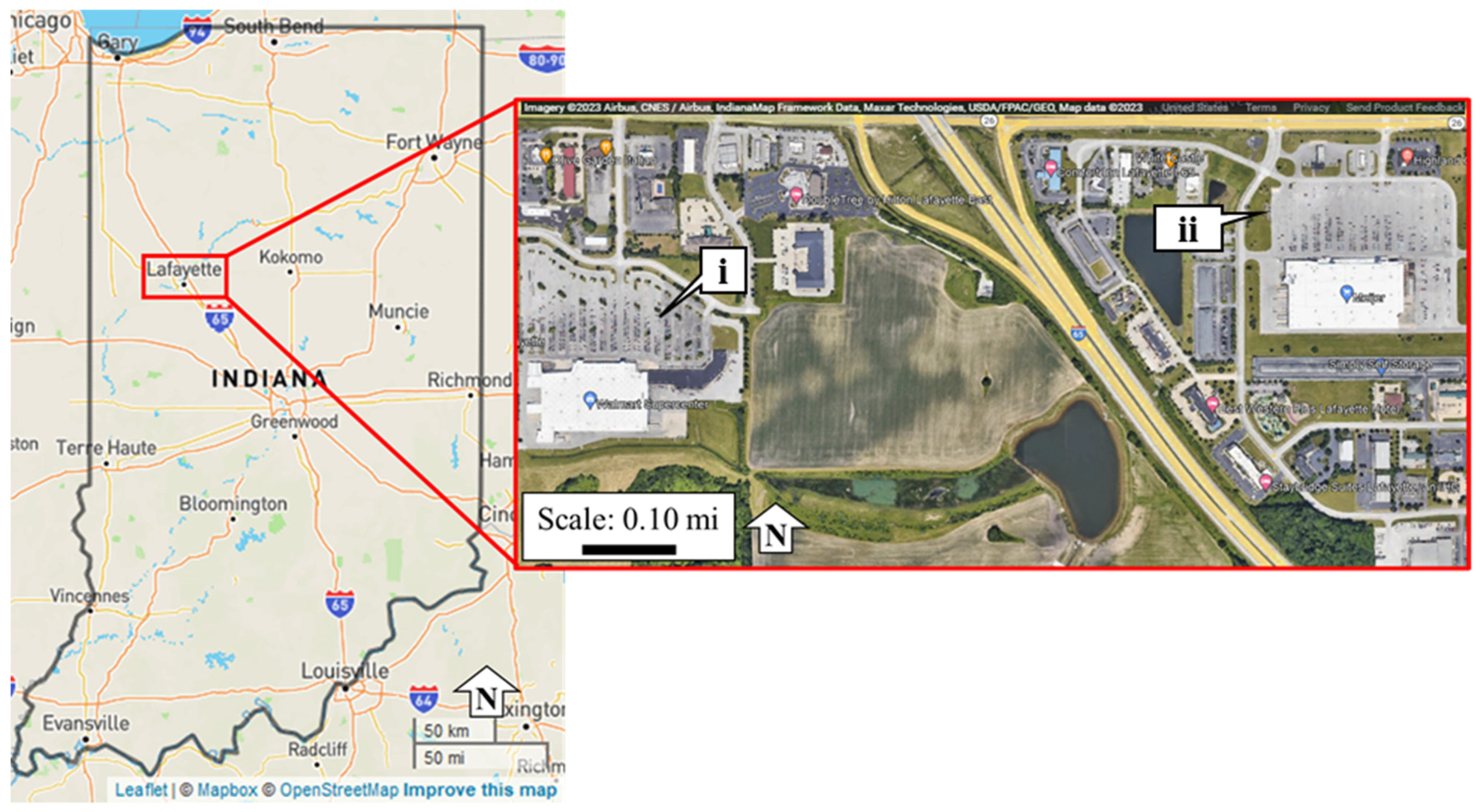
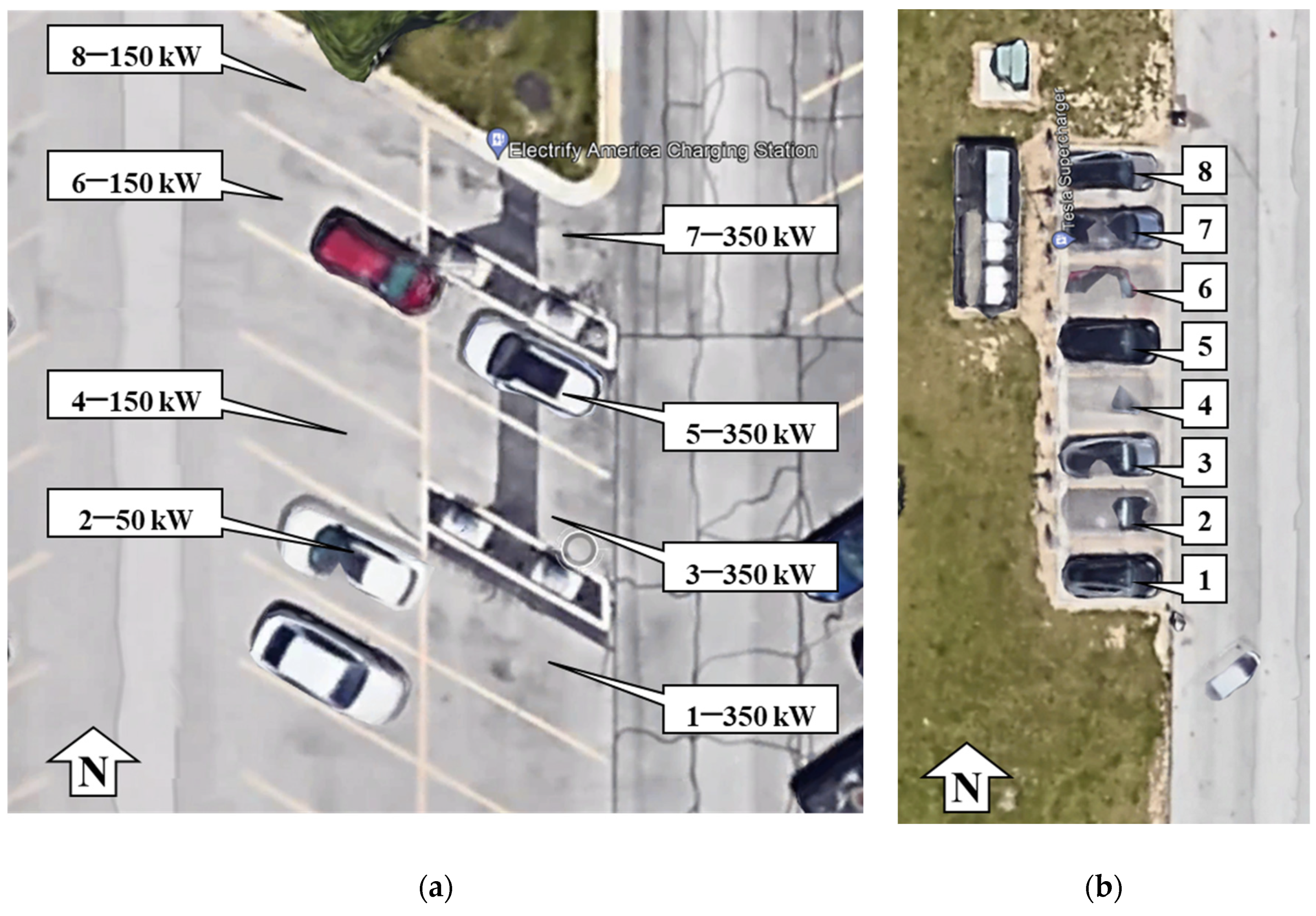

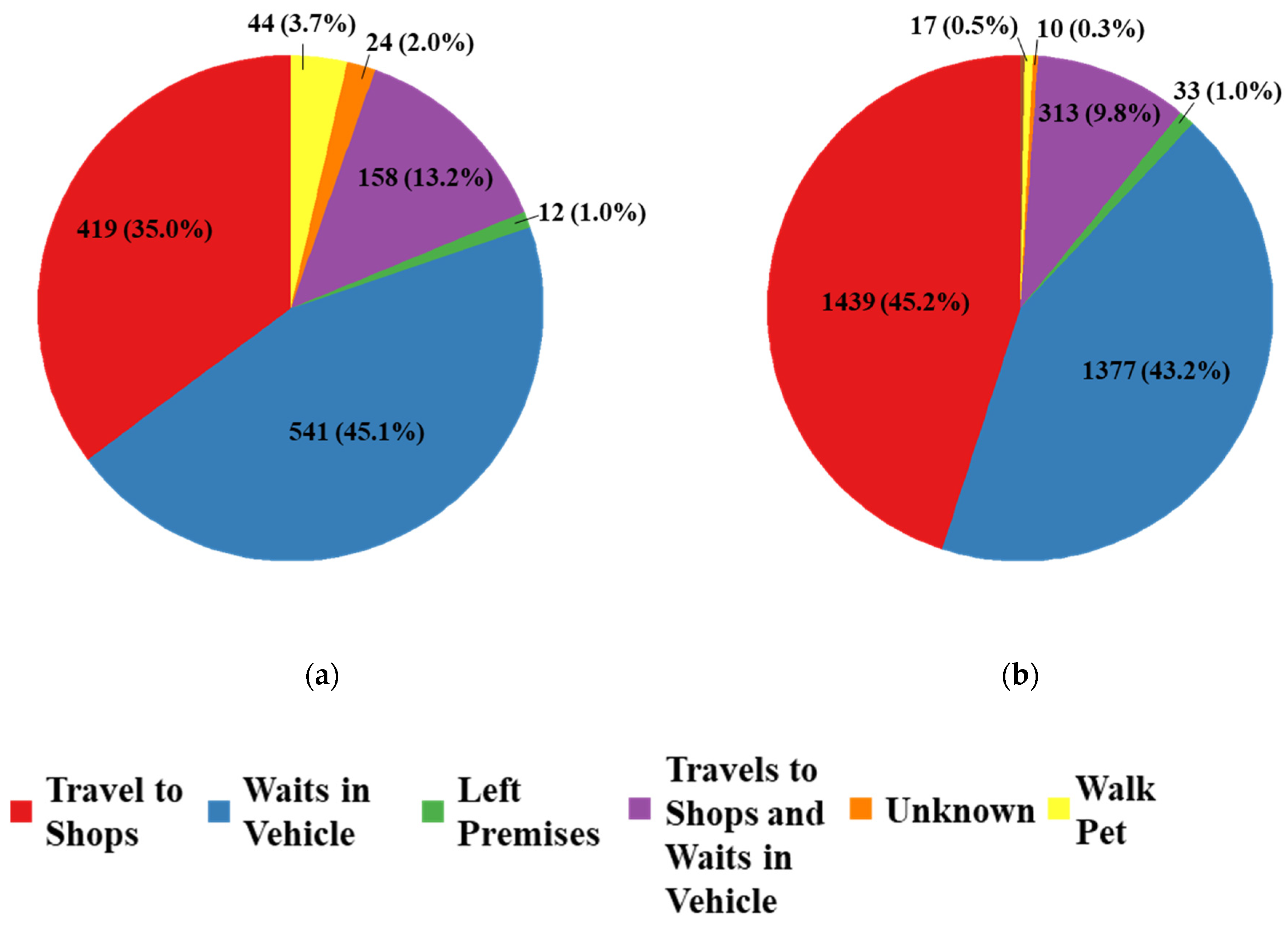
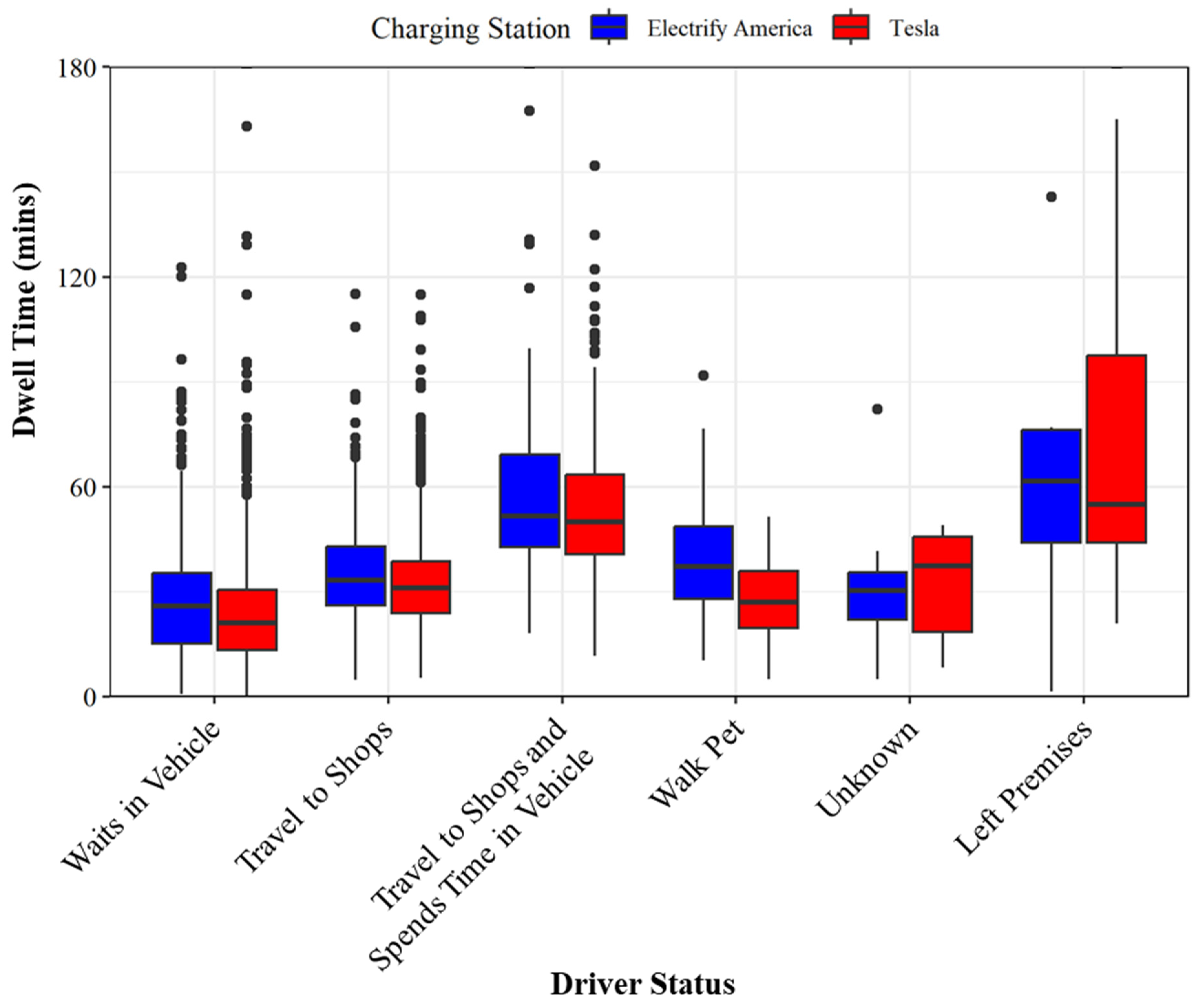
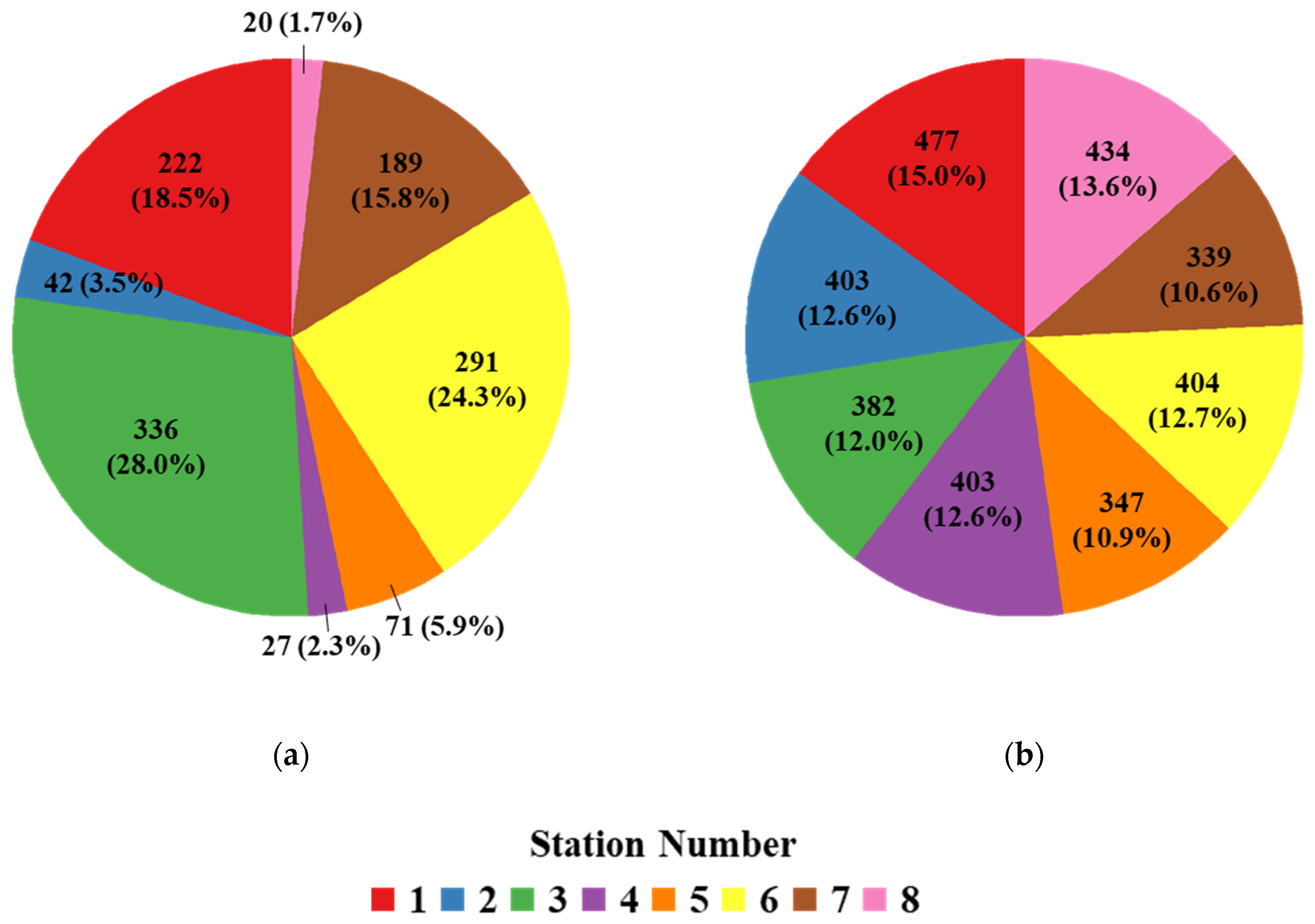

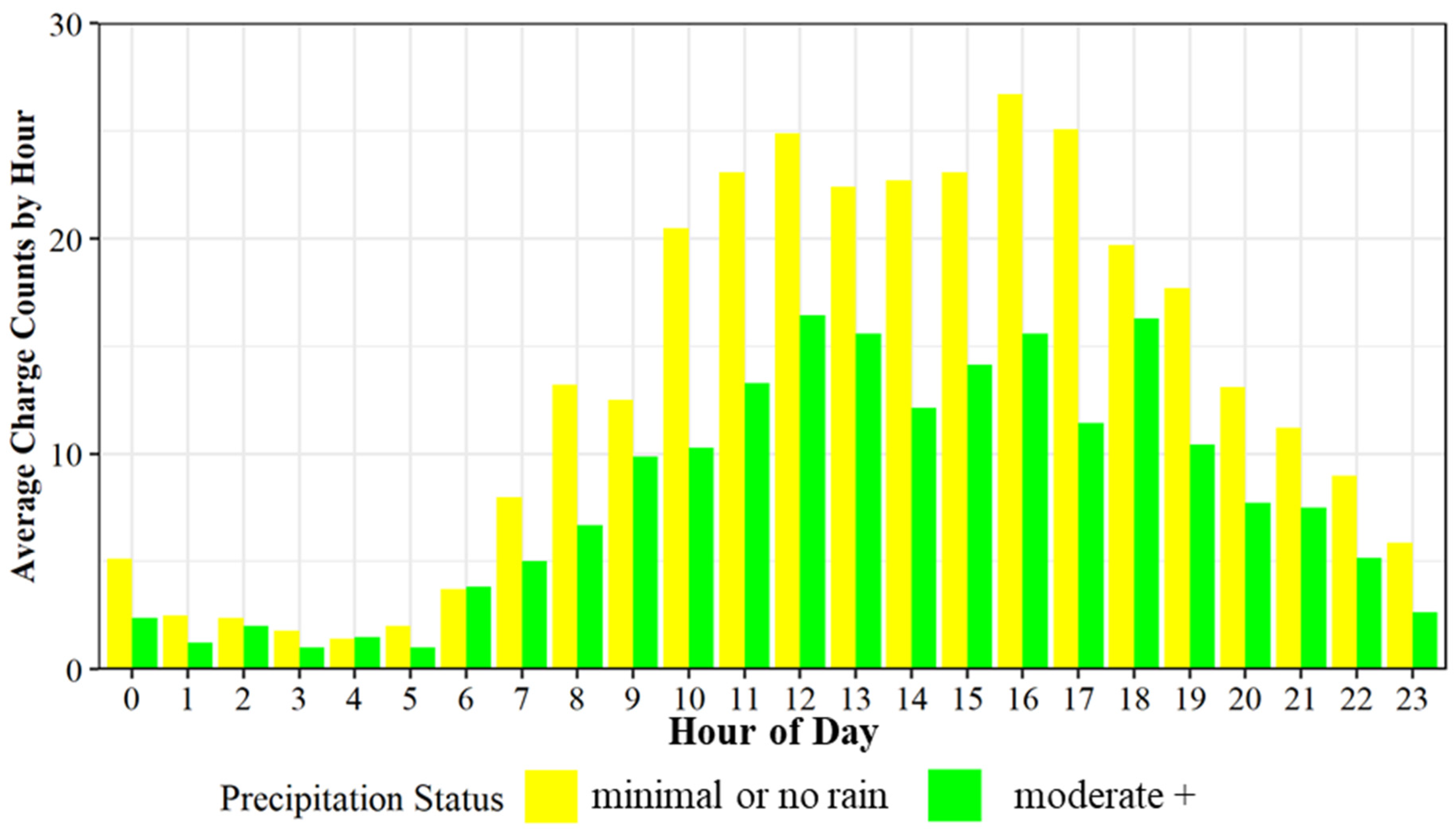
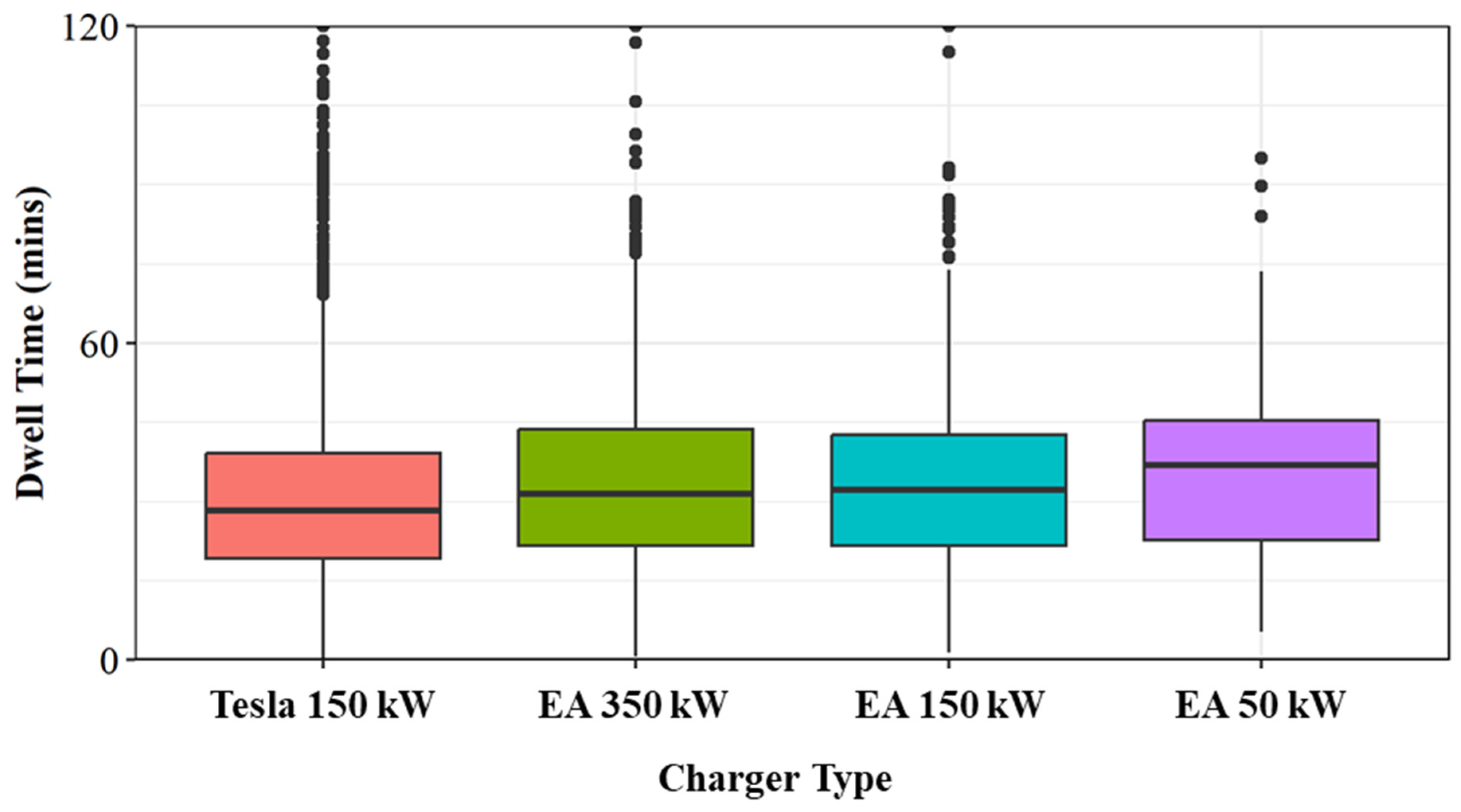
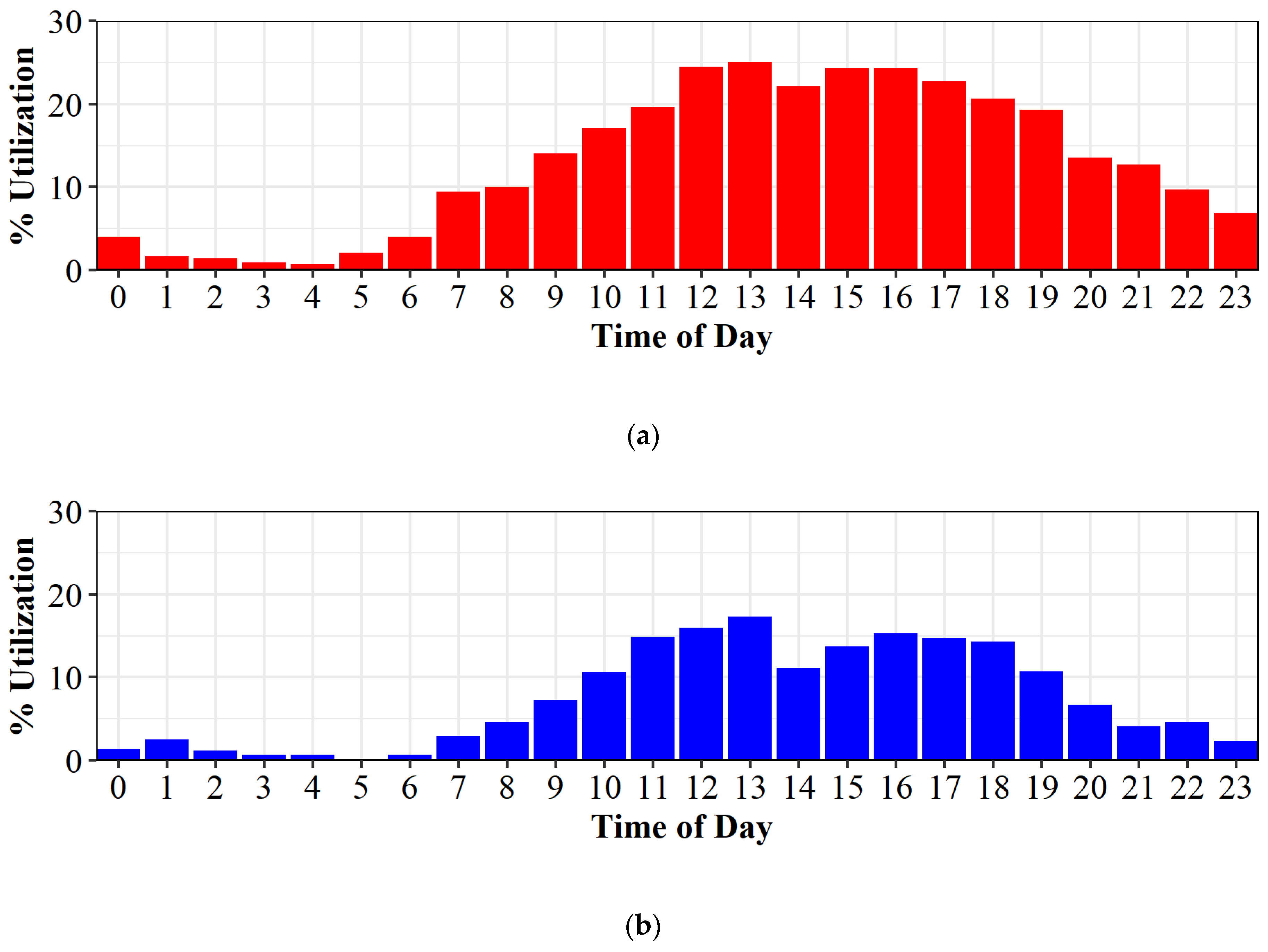

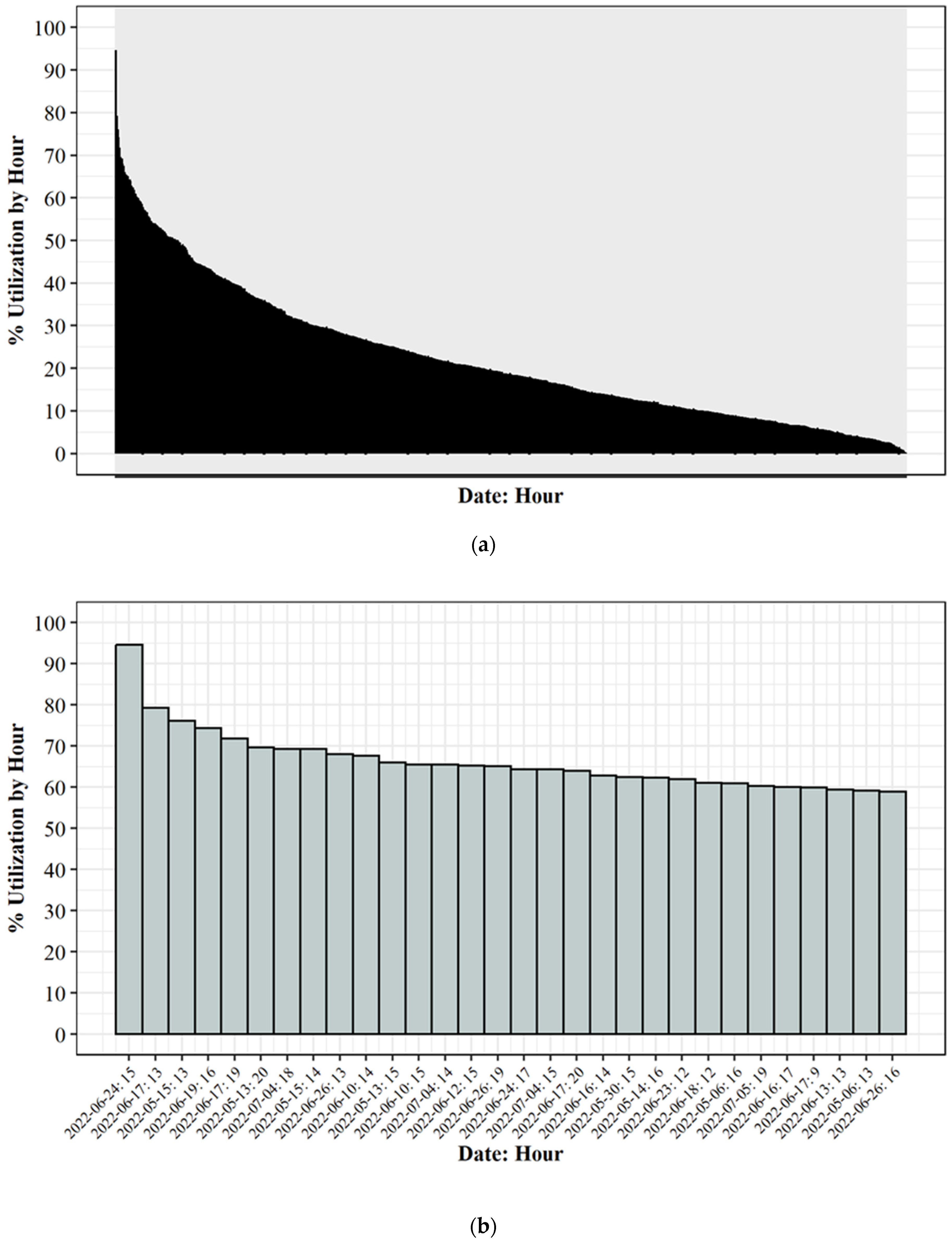
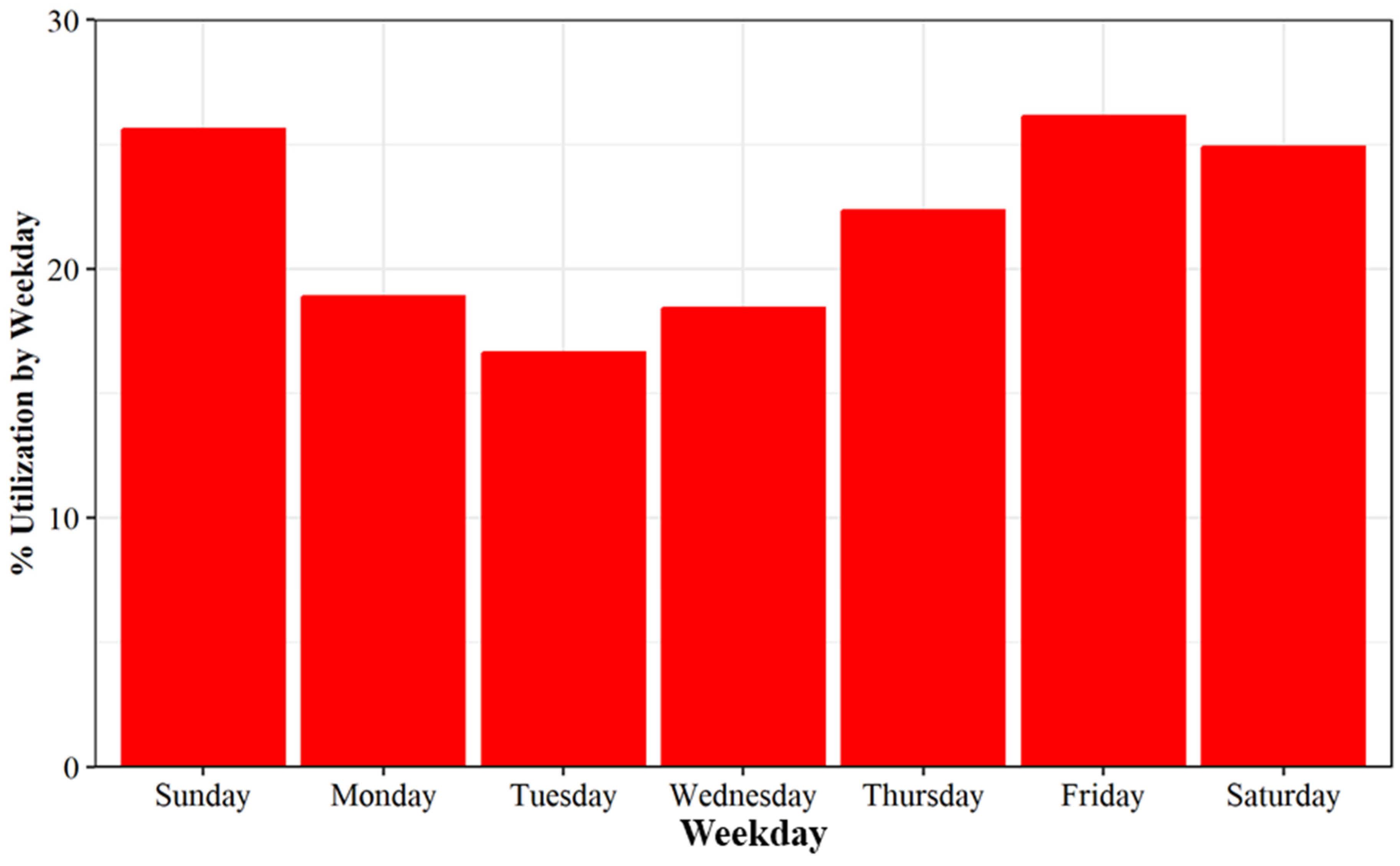
| Driver Activity | Number of Electrify America Observations | Electrify America Percent (%) | Number of Tesla Observations | Tesla Percent (%) |
|---|---|---|---|---|
| Waits in Vehicle | 541 | 45.1% | 1377 | 43.2% |
| Travels to Shops | 419 | 35.0% | 1439 | 45.2% |
| Travels to Shops and Waits in Vehicle | 158 | 13.2% | 313 | 9.8% |
| Walks Pet | 44 | 3.7% | 17 | 0.5% |
| Unknown | 24 | 2.0% | 10 | 0.3% |
| Left the Premises | 12 | 1.0% | 33 | 1.0% |
| Station | Electrify America Observations | Electrify America Percent | Station | Tesla Observations | Tesla Percent |
|---|---|---|---|---|---|
| Station 1 (350 kW) | 222 | 18.5% | Station 1 (150 kW) | 477 | 15.0% |
| Station 2 (50 kW) | 42 | 3.5% | Station 2 (150 kW) | 403 | 12.6% |
| Station 3 (350 kW) | 336 | 28.0% | Station 3 (150 kW) | 382 | 12.0% |
| Station 4 (150 kW) | 27 | 2.3% | Station 4 (150 kW) | 403 | 12.6% |
| Station 5 (350 kW) | 71 | 5.9% | Station 5 (150 kW) | 347 | 10.9% |
| Station 6 (150 kW) | 291 | 24.3% | Station 6 (150 kW) | 404 | 12.7% |
| Station 7 (350 kW) | 189 | 15.8% | Station 7 (150 kW) | 339 | 10.6% |
| Station 8 (150 kW) | 20 | 1.7% | Station 8 (150 kW) | 434 | 13.6% |
Disclaimer/Publisher’s Note: The statements, opinions and data contained in all publications are solely those of the individual author(s) and contributor(s) and not of MDPI and/or the editor(s). MDPI and/or the editor(s) disclaim responsibility for any injury to people or property resulting from any ideas, methods, instructions or products referred to in the content. |
© 2023 by the authors. Licensee MDPI, Basel, Switzerland. This article is an open access article distributed under the terms and conditions of the Creative Commons Attribution (CC BY) license (https://creativecommons.org/licenses/by/4.0/).
Share and Cite
Mahlberg, J.A.; Desai, J.; Bullock, D.M. Evaluation of Electric Vehicle Charging Usage and Driver Activity. World Electr. Veh. J. 2023, 14, 308. https://doi.org/10.3390/wevj14110308
Mahlberg JA, Desai J, Bullock DM. Evaluation of Electric Vehicle Charging Usage and Driver Activity. World Electric Vehicle Journal. 2023; 14(11):308. https://doi.org/10.3390/wevj14110308
Chicago/Turabian StyleMahlberg, Justin Anthony, Jairaj Desai, and Darcy M. Bullock. 2023. "Evaluation of Electric Vehicle Charging Usage and Driver Activity" World Electric Vehicle Journal 14, no. 11: 308. https://doi.org/10.3390/wevj14110308
APA StyleMahlberg, J. A., Desai, J., & Bullock, D. M. (2023). Evaluation of Electric Vehicle Charging Usage and Driver Activity. World Electric Vehicle Journal, 14(11), 308. https://doi.org/10.3390/wevj14110308






